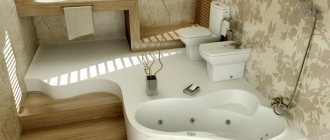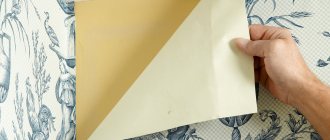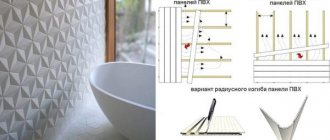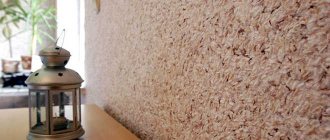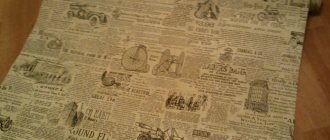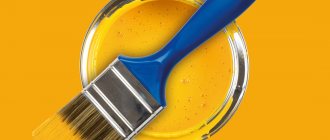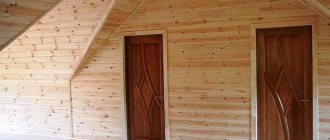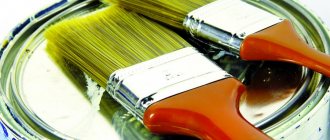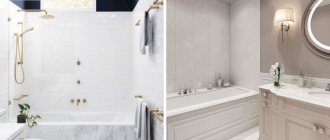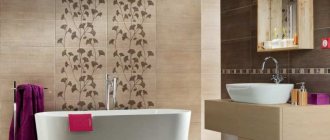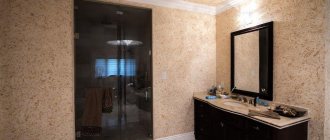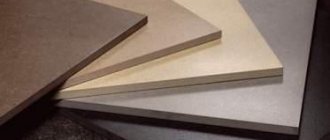A modern bathroom interior does not require wallpaper on the wall. But sometimes their presence turns out to be very useful. There are a large number of different types of this wallpaper on the construction market. They differ in structure, color and texture of the material. What are the advantages of this type of finish, how to choose the right one, how to paste wallpaper yourself - read below.
Wallpaper for the bathroom
The ability to use wallpaper in the bathroom allows you to significantly expand the range of design ideas
Benefits of wallpaper for the bathroom
Should you use wallpaper in the bathroom?
When in doubt: wallpaper or ceramic tiles, choose wallpaper because it has a number of advantages that other types of material do not have, namely:
- the cost of repairs will be low. For clarity, let’s take one meter of tiles, which costs 3,100 rubles. Expensive wallpaper, designed to order, has a similar price, but the calculation is not in meters, but in rolls. Add to this the cost of glue and labor;
- with the proper approach, you can paste wallpaper yourself, but laying tiles requires considerable experience;
- wallpapers update quickly. They took off the old ones and put on new ones. This number will not work with tiles. If there is tile in the bathroom, then most likely it will not be updated in the next 5 years. This process is very labor intensive and expensive;
- The last compelling argument for choosing wallpaper is that their range of colors and textures is much wider than that of ceramic tiles.
Black stylish wallpaper in the bathroom
If you decide to wallpaper your bathroom, choose high-quality models
No. 4. Liquid wallpaper for the bathroom: features and installation
Liquid wallpaper is another great alternative to regular ceramic tiles. Among their main advantages:
- complete immunity to moisture and water vapor;
- the application process is as simple as possible: no need to cut wallpaper, dilute glue, etc. Liquid wallpaper is somewhat reminiscent of plaster in terms of installation features;
- the material perfectly allows moisture to pass through, which can be called a clear advantage in a bathroom environment. In addition, liquid wallpaper provides additional heat and sound insulation;
- the ability to create a unique interior using liquid wallpaper, because materials of different colors can be combined with each other.
Experts advise covering liquid wallpaper after application with a layer of protective varnish to give it maximum resistance to moisture. In terms of application, liquid wallpaper is quite simple:
- First you need to prepare the surface and prime it. At the same time, you can begin to prepare liquid wallpaper by adding the amount of water indicated in the instructions to the dry mixture;
- apply wallpaper using a grater in an even layer 2-3 mm thick;
- After drying, you will be able to appreciate the surface without joints . In addition, do not forget to apply a protective layer of varnish.
Getting started with wallpapering
Hanging regular wallpaper is not much different from hanging washable wallpaper, but there are some nuances that need to be taken into account.
Tools you will need to work with wallpaper:
- glue brush;
- sponge;
- roller;
- roulette;
- scotch;
- putty knife;
- a simple pencil;
- plumb line (you can do it yourself);
- large container (basin or bucket);
- knife.
Wallpapering tools
Calculation of the number of wallpapers
Before purchasing material, carefully calculate how many rolls are needed. After counting, we take two more rolls. This will help to avoid minor troubles if the desired color suddenly runs out or there are small places that need to be sealed.
The algorithm for calculating materials is simple :
- Find out the perimeter of the room, divide the number by the width of the roll. This is how we calculate the number of canvases;
- Divide the length of the roll by the length of one sheet. Now we know the number of sheets in a roll;
- We calculate how many rolls are needed. Divide the first number by the second indicator.
How to calculate the number of wallpapers
See below for how to calculate wallpaper for a room.
Glue selection
In addition to wallpaper, you will need glue. It must be chosen carefully, depending on what wallpaper will be used. Wallpaper manufacturers usually indicate in the manual what adhesive is needed. Universal glue is not suitable for washable wallpaper. The solution must have a strengthened formula. In addition, the composition must contain antibacterial substances, they do not allow mold and fungi to appear.
Rules for choosing glue
The composition must be diluted strictly according to the instructions in the instructions, which are always on the package.
It happens that the manufacturer does not indicate the name of the wallpaper adhesive. In this case, you can use German Methylane glue. Henkel produces many types of glue; from this range it is easy to select the required composition.
Wallpaper glue Kleo
Wallpaper glue Moment
Wallpaper glue "Quelyd"
Wallpaper glue Metylan
When the wallpaper, glue and all the tools are at hand, you can get to work. All work is divided into two general tasks. The first task is to prepare the walls. The second is wallpapering.
What types of wallpaper can you use?
Choosing wallpaper for your bathroom is quite simple. There are several types of panels that are specifically designed for use in wet areas. Let's take a closer look at them.
Option #1: Washable wallpaper
Washable is a group of wallpaper intended for gluing in rooms with high humidity. Their peculiarity lies in a special coating that makes them wear-resistant. It does not allow the panels to “breathe”, so in rooms covered with such wallpaper there must be good ventilation.
The advantages of the material include:
- Versatility. Suitable for gluing to plaster, concrete, drywall and any other surfaces.
- Long service life, which is about 10-15 years.
- Easy to care for. Easy to clean with a damp cloth; if necessary, you can use a sponge and detergent.
- Easy to apply and equally easy to remove from walls.
You need to understand that washable wallpaper comes in different types, so when choosing it, it is important to pay attention to the labeling. The letters on the label will tell you what material was used to make the panels:
- BB – foamed vinyl;
- RV – embossed vinyl;
- PV – flat vinyl;
- STR – structural canvas for painting;
- STL – fiberglass.
In addition, all washable wallpapers are divided into types depending on the degree of moisture resistance. The following markings are used here:
- Straight line. Moisture-resistant wallpaper; it is not intended for washing. When gluing, it is allowed to remove excess glue with a damp sponge.
- Two lines. The panels can be washed using mild detergents.
- Three lines. The so-called “super washable” wallpaper. To clean them, you can use a sponge and saturated soap solutions.
- Brush and line. Such panels can be treated with detergent and a stiff brush.
- Brush and three lines. Particularly durable wallpaper with high abrasion resistance.
For bathrooms, you need to choose at least super-washable panels, and even better, wallpaper that can be washed with a brush.
In addition, it is better not to choose models with a pronounced texture, since from frequent washing, which is inevitable in the bathroom, they will quickly lose their appearance.
Particular care must be taken when gluing the joints of washable wallpaper. To prevent them from coming apart, you can lay narrow paper strips under them, coat them with glue again and roll them firmly with a rubber roller.
Before gluing washable wallpaper, it is important to carefully study the manufacturer’s recommendations; they may vary depending on the material of the panel. In general terms, the procedure for gluing moisture-resistant wallpaper is as follows:
- We calculate the number of whole stripes. To do this, divide the length of our wall by the width of the wallpaper roll. We cut off the required number of panels, not forgetting to add 50 mm to the length of the strip for trimming.
- Mark the gluing line for the first strip. To do this, we use a plumb line or a building level. Don’t forget that we start gluing the wallpaper from the window, so all the joints will be less noticeable.
- Using a roller or brush, apply glue to the first strip and, if required by the manufacturer, roll it up with the coated side inward and leave it to soak. Apply glue to the wall.
- Place wallpaper soaked in glue on the wall, aligning the edge with the marking line. Using a wide roller, press and roll the wallpaper to the wall, removing all air bubbles. Raise the canvas a little from the bottom and top, trim it and glue it again.
- Glue the remaining strips in the same way. At the same time, we strictly ensure that there are no overlaps at the edges. The joints can be additionally glued with a special compound and rolled with a narrow roller.
Moisture-resistant wallpaper is heavier than regular wallpaper, which is worth considering when choosing an adhesive. You should listen to the manufacturer’s recommendations and select only special compositions: for vinyl, acrylic, non-woven fabric, and so on.
When making fiberglass wallpaper, they are given a relief texture, which is emphasized very well by painting. Standard panels can withstand up to 15 stains, allowing the owner to change the appearance of the bathroom as often as he wants
Option #2: Glass wallpaper
Fiberglass wallpaper is one of the most practical and functional finishing options. They are made from fiberglass or the finest glass threads. Depending on the production method, the texture of the canvas will be different. If it is woven on a regular loom, the material will be almost smooth.
Feature of gluing fiberglass wallpaper: glue is applied only to the wall, but not to the canvas
Interesting relief fabrics are obtained after processing the threads on a special jacquard machine. Smooth panels are less dense, so they are rarely used for finishing. For decoration, heavier and denser relief fabrics are most often chosen. Advantages of fiberglass:
- Absolute safety. The material is completely environmentally friendly, since it contains natural substances: clay, quartz sand, soda and dolomite.
- Hypoallergenic. The canvas does not attract dust.
- High moisture resistance. Fiberglass wallpaper does not lose its properties when exposed to moisture and is not afraid of it.
- Breathability. The material “breathes”, which prevents the appearance of fungus and mold under the coating.
- The ability to apply several layers of paint; on average, the canvas can withstand 15-20 paintings.
- Easy to apply coating.
High-quality fiberglass wallpaper has no significant drawbacks. Experts do not recommend purchasing cheap analogues. Low-quality panels cannot even withstand unfolding and crack right in your hands. The technology for gluing glass wallpaper is very simple.
However, there are a few features to consider:
- When working with fiberglass sheets, you only need to wear long sleeves and protective gloves. When cut, glass fibers crumble and, when they come into contact with the skin, cause irritation.
- The front and back sides of the wallpaper are different. Usually they are wound inside with the front side.
- Before gluing glass wallpaper, the walls must be treated with a weak adhesive solution or primed.
- Such wallpaper is considered heavy, so it is necessary to use special compounds for gluing it.
The procedure for gluing fiberglass wallpaper in the bathroom is almost no different from gluing washable wallpaper. The only difference is that the panel does not need to be coated with glue. It is applied directly to the wall. The strips are glued end-to-end, any drops of adhesive that come out are removed with a clean, dry cloth.
Liquid wallpaper for the bathroom is a dry mixture, which is diluted in certain proportions with plain water. After swelling and thorough mixing, the coating is ready for use.
After gluing, glass wallpaper is most often painted using styrene-butadiene or acrylic paint.
Option #3: Liquid wallpaper
Wallpaper of this type is a special type of decorative plaster, the basis of which is cellulose fiber. The binding agent is CMC glue. In addition, liquid wallpaper may contain various additives that affect the texture and appearance of the coating.
It can be: cotton, natural silk, seaweed, plant bark, wool and so on. The advantages of liquid wallpaper include:
- No seams. The result of their application is an ideal smooth surface, whereas when gluing conventional panels, the seams will be noticeable.
- Environmental friendliness. The material contains natural fibers that are absolutely safe for humans. Liquid wallpaper is hypoallergenic and does not attract dust.
- Undemanding to the quality of the base. The coating can hide small wall defects. In addition, it can be applied in a new home. Shrinkage of the structure with liquid wallpaper is not dangerous.
- The ability to “breathe”, which prevents the occurrence of the “greenhouse effect” and, as a consequence, the occurrence of mold and mildew.
- Good sound and heat insulation.
- Maintainability. The coating must not be washed with aggressive detergents or rubbed with a brush. However, dealing with stains is very simple. You need to cut out the damaged piece and apply a new layer of liquid wallpaper.
- Large selection of colors and textures. Depending on the additives added to the base, such wallpaper can have a very different appearance and texture.
- Easy to apply and remove coating. The special structure of the wallpaper allows it to be applied to any surface configuration, even to pipes of different diameters. In this case, the coating lies tightly, without folds or creases.
The disadvantage of liquid wallpaper can be considered its relatively high cost. However, if we take into account the fairly long service life of the material, fairly low consumption and maintainability, we can conclude that, in terms of per square meter of wall, the cost is not so exorbitant.
Repairing a coating made with liquid wallpaper is very simple. You need to cut out the damaged area and apply a new compound to it. There will be no seams or joints left on the coating
Applying such a coating is not particularly difficult. The procedure is performed as follows:
- We are preparing the walls. To do this, remove the old coating and carefully putty all the cracks and other defects. To reduce material consumption, prime the base with any suitable composition.
- Strictly following the instructions, prepare the solution for application. To do this, pour the dry mixture with water and wait until it dissolves. After 20 minutes, mix the composition thoroughly, it is ready for use.
- Take a spatula or plastic trowel and apply liquid wallpaper to the wall from corner to corner. In this case, you should not press the tool hard, otherwise the material will be compressed and the texture of the coating will disappear. The application layer should be about 1-4 mm, it depends on the type of filler.
- We level the finished surface with a special plastic grater.
- Leave the coating for 48 hours to dry completely. The room where the wallpaper is drying should be well ventilated.
Another “minus” is sensitivity to moisture, so you need to choose a special coating for the bathroom. It has a special marking. If there are doubts about the moisture resistance of liquid wallpaper, after application they are covered with a protective layer of varnish.
Liquid wallpaper is applied to the wall using a spatula or trowel. Even a novice finisher can cope with such work.
A few tips to make your bathroom renovation easier
Tip #1
When wallpapering in the bathroom, try to avoid having wallpaper directly near water fixtures - next to faucets and sinks.
Tip #2
The spray must be applied with a spatula or trowel to a damp wall!
Tip #3
The primer is applied with oscillatory movements, from bottom to top. If it doesn’t work, you can do it with movements to the right and left.
Primer for wallpaper
Primer Moment
Tip #4
A rule that is sometimes forgotten. When repairing water in rooms such as a bathroom, it is necessary to turn off the water!
Tip #5
During repair work on sockets, the electricity is turned off. The plugs are unscrewed or the automatic transmission is turned off. The covers are removed, the sheets are glued over the holes. After this, a cut is made crosswise, the tails are tucked inside.
Wallpapering around switches and sockets
Wallpaper ideas that will delight
Since we already know that this is a practical solution and you can easily decide, let's take a look at what wallpaper for a bathroom can look like. Compositions in a modern style need decorations that will perfectly match the original design.
If you want to spice up your styling in gray or white and black, floral prints are a great idea. Bet on exotic flowers and green, lush palms, fern leaves or monstera. This way you will add some amazing decor and of course give a tropical feel to the bathroom.
If you like bright accents, let your imagination run wild and choose a pattern with colorful parrots or pink flamingos. Maybe you are looking for something for a traditional and classic space? The stripes, polka dots or lattice we know well will prove to be a hit.
When arranging this part of your apartment, we often have to deal with a small area. However, there is a way out - a solution - 3D wallpaper for the bathroom with a spatial pattern that imitates depth. Use a 3D mosaic or honeycomb pattern to add several square meters to a small area.
When decorating a bathroom, we often forget that interesting decorative accents can be introduced here not only in the form of colored towels or colored soap dispensers. Attractive wallpaper with a floral print or spatial pattern will enliven a monotonous room and also become a practical highlight of the composition.
If you decide to decorate your bathroom walls with wallpaper, you should know that it cannot be a standard product that is used, for example, in the living room, bedroom or living room. We are talking not only about paper wallpaper (which is obvious), but also about other types of wallpaper, for example, non-woven . When purchasing wallpaper for your bathroom , make sure it is washable and moisture resistant, as we said earlier.
Preparing the walls
Step 1. First, remove old wallpaper or tiles from the walls, if any. After this, wash the surface of the walls with a brush dipped in warm water.
How to remove old wallpaper
Step 2. Remove the layer of whitewash or plaster with a wide spatula, clean each pass with a brush. This removes dust and dirt.
Removing plaque from plastered walls
Step 3. On the main and level walls, make notches for better adhesion of the plaster and the wall surface.
Step 4. Inspect the walls for defects. If there are uneven spots, they need to be puttied. The first layer will be a spray 3-9 mm thick, and the second will be a primer. The thickness of the putty layer should not exceed 4 mm.
How to putty walls correctly
Step 5 . After applying the putty, smooth the surface with fine sandpaper.
Step 6. Wait for the surface to dry. This is a very important point! You can check the walls by sticking adhesive tape on the wall; if condensation appears, you need to wait. Only after the walls have dried can a primer be applied.
The video shows how to putty walls under wallpaper.
Bathroom: wallpaper or tiles?
Wallpapering a bathroom is an excellent, original, bold solution. The main thing here is to choose the type of paintings, their texture and shade, so that the finish goes well with other elements. It is very good if the renovation is carried out starting with the rough finishing of the bathroom. After reading the information, please leave your ratings and reasoning in the comments. They will be useful to other readers. Your opinion is very important to us. Thank you for your participation. We appreciate your every feedback and time spent.
- A wide selection of color options (in the case of liquid wallpaper, unlimited due to the use of colors).
- Low cost (even the most expensive canvases cost about the same as high-quality domestically produced ceramic tiles).
- Originality of decoration (wallpaper is rarely used in bathrooms, so you can create an attractive and non-standard interior).
Minuses
- The ability of a material to absorb water vapor.
- The appearance of mold on the finishing surface in case of insufficient ventilation in the room.
- The need to use special adhesive compositions suitable for use in rooms with high humidity. Regular glue will not work, because... When wet, it loses its properties.
Sources
_https://yellowhome.ru/2015/06/07/kak-vybrat-oboi-v-vannuyu/ _https://domsdelat.ru/steni/vlagostojkie-oboi-dlya-vannoj-komnaty-nepromokaemye-i-moyushhiesya .html _https://bouw.ru/article/vlagostoykie-oboi-dlya-vannoy-komnati _https://stroychik.ru/sanuzel/oboi-dlya-vannoj-komnaty _https://design-homes.ru/komnaty/ vannaya-komnata/oboi-dlya-vannoj-komnaty _https://modernplace.ru/oboi-dlya-vannoj/
Rules for mixing glue
After preparing the walls for gluing, stir the glue solution. This process has its own technology; it cannot be neglected. For washable wallpaper, only concentrated glue is suitable. It comes in granules and in the form of a ready-made mixture. The finished mixture is ideal for non-woven wallpaper.
There are adhesives that are not sold ready-made. You need to breed them yourself. They are considered more reliable than ready-made ones.
Instructions for diluting glue on the packaging
For thick and heavy wallpaper, as in this case, thick glue is suitable. We dilute the dry mixture.
Step 1. Pour warm water into a large container.
Amount of water for glue (per 1 pack)
Step 2. Open the package and make a medium-sized hole.
Step 3 . We take a stick and make circular movements in the water until a funnel is formed.
Step 4 . Pour the mixture into this funnel in a thin stream, without stopping stirring the water.
Dilution of wallpaper glue
Step 5 . We wait until the composition becomes thick, if necessary, add water.
Step 6. After 7-10 minutes, stir the mixture and let it rest for 15 minutes.
Where can I hang wallpaper?
You can wallpaper the walls near the sink, washing machine, toilet and walls inaccessible to splashes. It is better to tile the wall near the bathroom or shower with antifungal glue or putty. If there is free leftover material, you can use it to diversify plain wallpaper by inserting it into a frame.
The photo shows an example of a successful and correct combination of two types of finishes in color and texture: vinyl wallpaper near the sink and tiles in the shower and toilet.
The photo shows a black and white design, with white dominating. Tiles protect the bathtub and shower area, and realistic-sized patterned wallpaper is applied throughout.
Wallpaper care
Although wallpaper is called washable, you should not water it with water and cleaning products every day. It is better to wipe the surface of the coating with a damp sponge or cloth. If you really cannot do without chemicals, limit yourself to a weak soap solution. With the advent of modern technology, some people prefer to use a washing vacuum cleaner. This is absolutely not allowed! Wet cleaning can leave stains and smudges, and a brush can damage the structure of the wallpaper.
Before you start cleaning, try wiping a small section of the wall to make sure the wallpaper is intact and intact. Study bathtubs made of cast marble at the link.
Pictured is wallpaper in the bathroom
Combining wallpaper and tiles
The combination of two types of finishes allows you to create a comfortable interior and protect the most humid areas.
The wall above the bathtub, near the shower stall and sink, as well as the decorative screen can be laid with ceramic or glass tiles, and the floor can be tiled with porcelain stoneware or ceramics with a relief texture. Surfaces near the toilet, washing machine, toilet cabinet and heating appliances are covered with moisture-resistant wallpaper.
When combining materials, it is recommended to select single-color tiles. Wallpaper can be a uniform color or have a small pattern.
When combining wallpaper and tiles, you need to pay attention to the following recommendations:
- For the walls of a small bathroom, medium-sized rectangular tiles (30 cm) are suitable;
- It is advisable to select wall and floor tiles from the same collection;
- the combination of samples should be evaluated under the same lighting as in the future bathroom (warm or cold light);
- vertical or horizontal joints must be smooth.
An example of finishing a bathroom with washable wallpaper and tiles.
The junction of tiles and paper strips can be vertical, horizontal or diagonal. Tiles can also be laid with the elements offset relative to each other.
Combining wallpaper with other materials
Wallpaper goes well with other types of coatings:
- ceramic tiles. Most often used to decorate the wall behind the bathroom, it is present as decorative elements: inserts, borders, panels. To create contrast, combine light wallpaper with dark tiles and vice versa. To hide the structure of materials, use ceramics that will be 1-2 shades darker or lighter from the walls;
- plastic panels. They are easy to install, practical, can withstand heavy loads, and do not deteriorate under the influence of temperature changes. They look good together with photo wallpaper. Using panels of different colors you can create a striped decor;
- natural materials (marble, wood, natural stone). They are environmentally friendly, look beautiful in design, but are susceptible to rotting and should be treated with water-repellent agents.
Look how well the wallpaper is combined with plastic panels in the photo.
How to finish?
Let's figure out how to carry out finishing work using self-adhesive films. This material can be glued to almost any material – concrete, wood, glass, metal. But on walls covered with putty and on untreated drywall, self-adhesives do not adhere well.
Preparation
The quality of finishing largely depends on how well the preparatory work is carried out. The following work needs to be done:
- remove the previous finish;
- We carry out work to level the wall;
- apply finishing putty, clean the surface with sandpaper;
- apply primer in two layers;
- let the wall dry thoroughly.
Pasting
First you need to cut the film into pieces of the required length. This is not difficult to do, since the protective paper has markings that make cutting easier. Then you can start applying the sticker, you need to do this:
- markings are applied to the wall, for this you should use a level and plumb line;
- a strip of wallpaper is applied in place of the sticker without removing the protective layer to make sure that it fits as required;
- then part of the protective layer is separated from the top, revealing the adhesive layer by about 2 cm;
- the film is applied in place and smoothed;
- Now they begin to gradually (5-6 cm) separate the protective layer, pressing the film against the wall. In this case, you need to ensure that no folds form on the surface and that the strip lies flat.
Common mistakes
In order to avoid disappointment and spoil the purchased materials, it is worth learning from the mistakes of others. Here is a list of what not to do:
- Glue wallpaper on an unprepared surface. If you try to stick the film on a curved surface, then all the wall defects will be clearly visible through the finish.
- Forget to apply primer. The surface is primed to ensure that the film adheres better to the wall. If you do not perform this operation, there is a risk that the wallpaper will fall off soon after pasting.
- Don't let the wall dry out. Self-adhesive materials should only be applied to a dry surface. In damp areas, the film will peel off, forming bubbles.
- Remove large areas of protective paper at once. If you release the entire adhesive layer at once, then with almost 100% probability this strip of wallpaper will be damaged. Most likely, the strip will stick together on the wrong side and it will be impossible to separate it.
Advantages and disadvantages
Before using self-adhesive for finishing, it is worth getting acquainted with the properties of this material. After all, like any other finishing material, it has its positive and negative qualities.
pros
Let's start by describing the strengths of the material. Main advantages:
- a huge variety of colors and textures;
- low price when it comes to polymer films;
- practicality, good performance;
- installation is as simple as possible, no need to purchase additional materials and tools;
- Films can be glued not only to walls, but also to curved surfaces, for example, to communication pipes.
Minuses
The material also has disadvantages. This is, first of all, vapor tightness. Because of this quality, the walls in the bathroom will not “breathe”, and this can lead to mold starting to grow on the walls.
Advice! If you plan to use polymer film to decorate the walls, then you should check the ventilation in the bathroom in advance. It’s even better to arrange forced ventilation by installing an electric fan in the ventilation hole.
Another disadvantage is that without proper skill it will be difficult to apply self-adhesive wallpaper. Despite the fact that gluing such films is not difficult, performing this work requires some dexterity.
